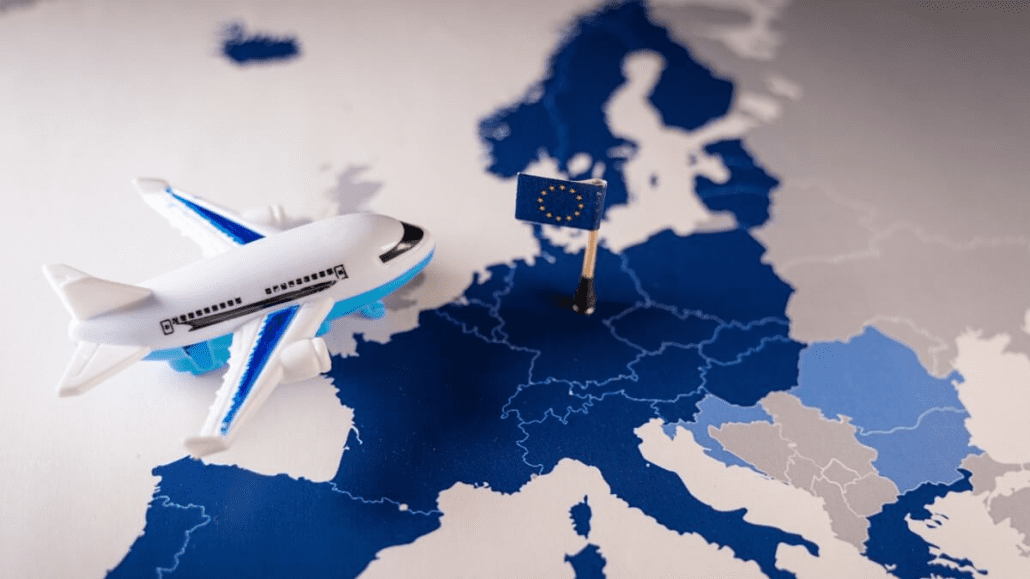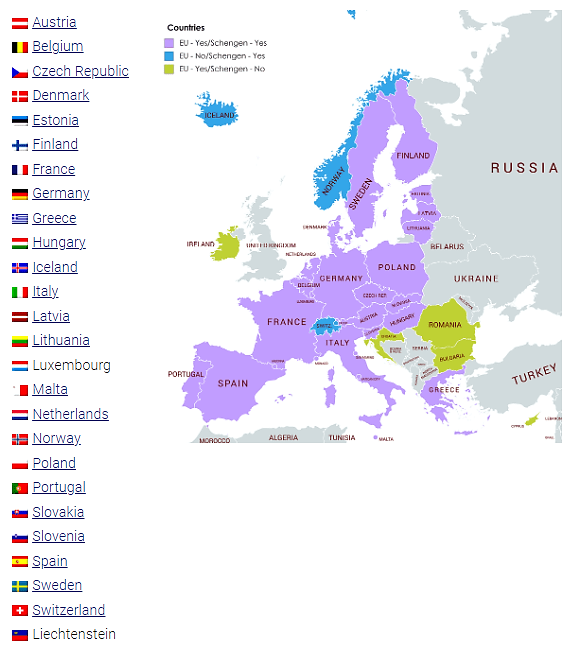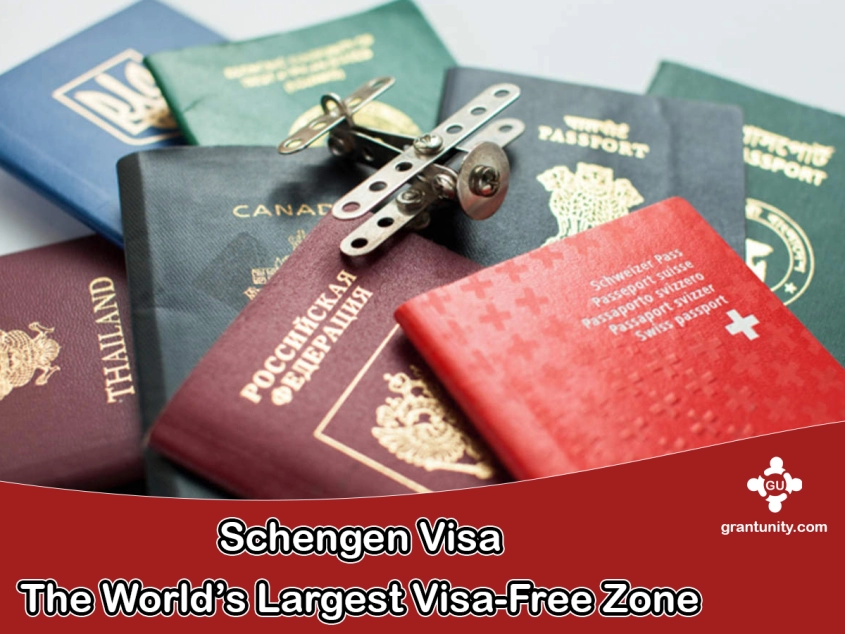Schengen Visa: The World’s Largest Visa-Free Zone
The Schengen Area is a region in which 26 European nations have abolished their internal borders to allow for the unhindered and unrestricted movement of people in accordance with common regulations for policing external borders and combating crime by enhancing judicial and police cooperation.
Except for Ireland and the nations that will soon join the Schengen Area—România, Bulgaria, Cyprus, and Croatia—the Schengen Area encompasses the majority of the EU member states. Countries like Norway, Iceland, Switzerland, and Lichtenstein are included in the Schengen area despite not being EU members.
The 26 Schengen countries are Austria, Belgium, Czech Republic, Denmark, Estonia, Finland, France, Germany, Greece, Hungary, Iceland, Italy, Latvia, Liechtenstein, Lithuania, Luxembourg, Malta, Netherlands, Norway, Poland, Portugal, Slovakia, Slovenia, Spain, Sweden, and Switzerland.
There are currently 26 nations that make up the Schengen Area. These nations are all in Europe, and they come from:
- 22 members fully implement the Schengen acquis,
- Four of them – members of the EFTA, implement Schengen acquis through specific agreements related to the Schengen agreement.
- Although they are not members of the EU, Iceland, Norway, Switzerland, and Lichtenstein is associate members of the Schengen Area. Through specific agreements related to the Schengen agreement, they implement the Schengen acquis as members of the EFTA.
- Monaco, San Marino, and Vatican City have opened their borders, but are not members of the visa-free zone.
- Despite being outside of the European continent, the Azores, Madeira, and the Canary Islands are special members of the EU and a part of the Schengen Zone.
- In addition to Ireland, which continues to maintain opt-outs, five other EU members have not yet joined the Schengen area: Romania, Bulgaria, Croatia, and Cyprus, all of which are pursuing membership applications.
80 percent of the 50,000 km-long Schengen Zone’s external borders are made up of water, and the remaining 20 percent is made up of land. The region has 4312,099 km2 in size, hundreds of airports and maritime ports, numerous land crossing points, and a population of 419,392,429 people.

Visa Information for Schengen countries
All 26 Schengen Area members are accessible to travelers with uniform Schengen visas:
| Austria | Hungary | Norway |
| Belgium | Iceland | Poland |
| Czech Republic | Italy | Portugal |
| Denmark | Latvia | Slovakia |
| Estonia | Liechtenstein | Slovenia |
| Finland | Lithuania | Spain |
| France | Luxembourg | Sweden |
| Germany | Malta | Switzerland |
| Greece | Netherlands |
Austria
Austria, one of the richest nations in the world in terms of GDP per capita, has an area of 83,871 km2 and 8,712,137 inhabitants. On April 28, 1995, the nation formally ratified the Schengen Agreement. But on December 1, 1997, it began to be put into practice, more than two years later.
Centrally located in Europe, Austria shares borders with eight nations—more than the majority of its European neighbors. One of the most popular tourist destinations in all of Europe is Vienna, the country’s capital.
Belgium
One of the original five nations to ratify the Schengen Agreement on June 14, 1985, Belgium began putting it into effect on March 26, 1995. With a population of 11,358,379 people and a land area of 30,528 km2, it is a small but densely populated nation.
The nation, which is a part of Western Europe, is bordered by France, the Netherlands, Germany, and Luxembourg. The European Union’s administrative hub is located in its capital city, Brussels, which is frequently referred to as the EU capital city.
Czech Republic
The nation, formerly known as Czechoslovakia, was only founded in 1993 after the peaceful breakup of that state. The 78,866 km2 nation in central Europe is bordered to the west by Germany, to the south by Austria, to the east by Slovakia, and to the northeast by Poland.
10,610,947 people call it home, 64.3 percent of whom are Czechs; the remainder is Slovaks, Moravians, Ukrainians, and others. With Prague ranking as the fifth most visited city on the old continent, the nation derives a sizeable portion of its income from tourism.
On 16 April 2003, the Czech Republic ratified the Schengen Agreement, and on 21 December 2007, it began to implement it.
Denmark
The Scandinavian nation’s southernmost nation is Denmark. It is situated south of Norway and southwest of Sweden, covering an area of 43,094 km2. Germany is its neighbor to the south, whereas.
The Schengen agreement was ratified by the Danish government on December 19, 1996, and its implementation began on March 25, 2001. However, due to threats from ongoing significant secondary movements and the security situation in Europe, Denmark is currently one of the six Schengen nations with reinstituted border controls.
With a population of 5,785,864 people, the Nordic region has one of the highest standards of living in both Europe and the entire world.
Estonia
The Baltic Sea, Latvia, the Gulf of Finland, Lake Peipus, and Russia form the eastern, northern, and western borders of the Republic of Estonia in northern Europe. It is one of the least populous countries in Europe, with a total area of 45,338 km2 and 1,312,442 inhabitants. In the Baltic Sea, there are 2,222 islands and islets that make up this flat country.
The territory that makes up modern-day Estonia has historically been governed by the Danish, the Swedish, and most recently, the Soviet Union. On 16 April 2003, its government ratified the Schengen Agreement, and on 21 December 2007, it began to implement it.
Finland
The Nordic nation, officially known as the Republic of Finland, is bordered to the north by Norway, to the northwest by Sweden, and to the east by Russia. It is renowned for its educational system and for being among the safest and greenest nations on the planet. The happiest nation on Earth is home to 5,503,132 people.
The total area of Finland is 338,145 km2. It began implementing the Schengen pact on March 25, 2001, after signing it on December 19, 1996.
France
France, the most traveled nation in Europe, is not solely known for the Eiffel Tower. The nation, which is known for its fine wine, extreme diversity, historical sites, and opulent ski resorts, attracted 85.7 million foreign visitors in 2013, the most ever.
Eight European nations share borders with the 551,695 km2 nation: Andorra and Spain in the south and southwest, Belgium and Luxembourg in the northeast, Germany and Switzerland in the east, and Italy and Monaco in the southeast.
As one of the five nations that established the Schengen Zone on June 14, 1985, it is home to 65,598,772 people who are free to travel anywhere within it. On March 26, 1995, the agreement’s implementation in France got underway.
Germany
Germany, the second-most visited Schengen country and the land of invention and innovation, has 16 separate states and a total area of 357,386 km2. The European nation with the greatest number of international borders is also the most populous member of the EU.
It is situated in Western and Central Europe, bordered to the north by Denmark and to the east by Poland and the Czech Republic. In addition to Austria to the southeast, Switzerland to the south-southwest, France, Luxembourg, and Belgium to the west, and the Netherlands to the northwest, it is bordered by these countries.
German passport holders can travel to 188 countries without a visa, making it one of the top three most useful passports in the world.
One of the original five signatories of the Schengen Accord on June 14, 1985, is Germany. On March 26, 1995, ten years later, it began to be implemented.
Greece
At the confluence of Europe, Asia, and Africa is Greece, the birthplace of Western civilization. The Hellenic Republic is credited with being the origin of democracy, western literature, history, political science, the Olympics, and other cultural innovations.
Today, Greece shares land borders with Albania in the northwest, North Macedonia and Bulgaria in the north, and Turkey in the northeast, even though its borders have changed over the year. Greece began implementing the Schengen agreement on 1 January 2000 after signing it on 6 November 1992, but none of its neighbors have yet to do the same.
11,183,716 people live in the 131,990 km2 nation. Greece is a popular travel destination because of its distinctive cultural heritage, stunning islands, and beaches.
Hungary
Hungary is a country in Central Europe with a population of 9,753,281 people and a land area of 93,030 km2. Its land borders with Slovakia, Ukraine, Austria, Romania, Serbia, Croatia, and Slovenia are all to the north, northeast, northwest, and northwest, respectively.
Each year, a large number of tourists come to the country. It received 263,940 visa requests in 2017. Hungary is a popular destination for tourists seeking medical care in Europe. Its market share is 21% globally and 42% in Europe for just dental travel.
It began implementing the Schengen agreement on December 21, 2007, after signing it on April 16, 2003.
Iceland
The volcanically and geologically active Nordic island nation is situated in the North Atlantic. 348,580 people are living there, with two-thirds of them living in Reykjavik, the country’s capital, and the neighborhood. The nation covers 103,000 km2 of land.
The top tourist attractions in Iceland include ecotourism and whale-watching. However, the nation received 7,610 visa requests in 2017, the fewest of any other state.
On December 19, 1996, it ratified the Schengen Accord for the first time. After the Treaty of Amsterdam included the agreement in EU law, it was replaced by a new agreement that was signed on May 18, 1999. On March 25, 2001, Iceland formally began implementing the agreement.
Italy
In the center of the Mediterranean Sea is the independent nation-state of the Italian Republic. Its borders with France, Switzerland, Austria, Slovenia, San Marino, and Vatican City total 301,318 km2. It is the fourth most populous EU member with 59,429,938 people.
Italy is the successor to the vast Roman Empire, whose rich history and numerous cultural attractions have helped Italy rise to the top of the list of travel destinations in Europe. The world’s most renowned scholars, artists, and polymaths, including Michelangelo, Leonardo da Vinci, Raphael, Galileo, and Machiavelli, were all born in Italy.
After signing the agreement on November 27, 1990, it began putting it into practice on October 26, 1997.
Latvia
The Republic of Latvia shares borders with Belarus to the southeast, Estonia to the north, Lithuania to the south, and Russia to the east. With a total area of 64,589 km2, the nation has 1,970,530 people.
Currently, Latvia is a part of the EU, NATO, the CE, the UN, CBSS, the IMF, NB8, NIB, OECD, OSCE, and WTO. It joined the European borderless territory when it ratified the Schengen agreement on 16 April 2003 and began implementing it on 21 December 2007.
Riga, the nation’s capital, is renowned for its Old Town, a UNESCO World Heritage Site, and its architecture. 2014’s designation of Riga as the European Capital of Culture.
Liechtenstein
Located in Central Europe, the principality of Liechtenstein is a German-speaking microstate that is doubly landlocked. It is the fourth-smallest country in Europe with a mere 160 km2 and 37,666 inhabitants.
Switzerland and Austria are Liechtenstein’s neighbors to the west, south, and north, respectively. The majority of the nation is mountainous, making it a desirable location for winter sports. It was the final nation to join the Schengen region without borders.
Lithuania
The 65,300 km2 nation is bordered to the north by Latvia, to the east and south by Belarus, to the south by Poland, and the southwest by Kaliningrad Oblast, a Russian exclave. Its population is 2,908,249 and its official currency is the euro.
One of the oldest languages still spoken today is Lithuanian. It is also one of just two still spoken languages in the Indo-European language family’s Baltic branch, along with Latvian.
On 16 April 2003, Lithuania ratified the Schengen Agreement, and on 21 December 2007, it began to implement it.
Lithuania received more visa requests in 2017 than Austria, Portugal, Sweden, Denmark, and Norway combined (413,966 applications). In Lithuania, there are three UNESCO World Heritage Sites.
Luxembourg
With a total area of 2,586 km2, Luxembourg is home to 575,747 people. It is one of the founding members of the Schengen Accord, which was established on June 14, 1985, in the Luxembourgian village of Schengen. One of the three official capitals of the European Union is Luxembourg City, the nation’s capital.
Luxembourg is the second-richest nation in the world, according to GDP. It is one of the safest nations in the world and has the highest minimum wage in the EU.
“Mir wllebleiwewatmirsinn,” the nation’s motto, is an acronym for “we want to remain what we are.”
Malta
The Mediterranean Sea archipelago that makes up the island nation of Southern Europe is 316 km2 in size and home to 429,362 people.
Despite its small size, the nation received 37,881 visa requests in 2017. It is primarily recognized in the travel industry for its beaches, sea, and sun. Ancient wonders like the 4,000-year-old Hal Saflieni Hypogeum and the 5,000-year-old Hagar Qim are some of its most alluring tourist destinations.
Malta began putting the Agreement into practice on December 21, 2007, after signing it on April 16, 2003.
Netherlands
The Netherlands, which has twelve provinces, is best known for its vibrant tulips, numerous windmills, and delectable cheese. Belgium, Germany, and the North Sea are the nation’s neighbors to the east, south, and northwest, respectively. It has 16,987,330 inhabitants and a 41,526 km2 area.
It is a founding member of the WTO, OECD, NATO, Eurozone, EU, and G10. Additionally, it was one of the original five signatories of the Schengen pact on June 14, 1985.
The Port of Rotterdam, which is located in the Netherlands, is the biggest port in Europe and the biggest port outside of Asia. This Western European nation is the second-largest exporter of beer in the world, after Mexico, and it has the highest level of English proficiency in the entire world.
Norway
Norway, the country with the midnight sun, covers an area of 385,155 km2. 5,254,694 people identify as Norwegians living there. To the northeast, it shares a border with Finland and Russia; to the south, it shares a border with Denmark at the Skagerrak Strait.
The country’s breathtaking fjords and Viking heritage are the main draws for tourists. In 2017, 196,082 visa requests were submitted to Norwegian embassies around the world.
The Schengen Accord was signed by Norway on December 19, 1996. The first agreement expired on May 18, 1999, and was replaced by a new one after the Treaty of Amsterdam made it part of EU law. On March 25, 2001, Norway began putting the agreement into practice.
Because some parts of the country experience 24 hours of sunlight for a portion of the summer, it is known as the “land of the midnight sun.”
Poland
Located in Central Europe, Poland is a member of the EU. Its area is 312,683 km2, and it has 16 administrative subdivisions. The nation, which has a population of 38,224,410, borders Germany, Russia, Lithuania, Ukraine, Slovakia, the Czech Republic, and Belarus.
Warsaw, the medieval town of Malbork, Lublin, Torun, Krakow, and Poznan are its most well-known and popular cities. The Tatra National Park and the Bialowieza Forest are two additional attractions in Poland. According to statistics, Germans make up the majority of visitors, followed by Britons and Russians.
The agreement was signed on 16 April 2003, and implementation got underway in late 2007.
Portugal
Portugal, the nation at the westernmost point of Europe, only has land borders to the north and east with Spain. It has 10,371,627 inhabitants and a 92,391 km2 area.
It is one of the oldest countries in Europe and the oldest state on the Iberian Peninsula. The nation attracts many tourists all year long thanks to its reputation for football, gorgeous beaches, and historical sites. Lisbon, the country’s capital, the subtropical island of Madeira, Porto, Portugal’s second-largest city, the small fishing village of Ericeira, and videos, a region famous for its numerous medieval castles, are the most popular destinations in Portugal.
Portugal and Spain were the only neighbors to sign the Schengen agreement, which was put into effect on March 26, 1995.
Slovakia
Slovakia is a landlocked nation in Central Europe with a 49,037 km2 area. 5,444,218 of its inhabitants identify as Slovak and speak Slovak. With Poland to the north, Ukraine to the east, the Czech Republic to the west, Hungary to the south, and Austria to the southwest, the nation has shared borders.
After the peaceful breakup of Czechoslovakia on 1 January 1993, Slovakia gained independence. On April 16, 2003, ten years later, it signed the Schengen pact. On December 21st, 2007, it began carrying out this convention.
The world’s highest concentration of castles and chateaux per person is found in Slovakia. One of the most well-known is the Spi Castle, which is included in the UNESCO List of World’s Cultural and Natural Heritage.
Slovenia
The population of Slovenia is 2,077,862 and its area is 20,273 km2. It shares borders with Croatia to the southeast, Hungary to the northeast, Austria to the north, and Italy to the west.
Slovenia, which is smaller than Liechtenstein, Luxembourg, and Malta, is a member of the Schengen Area. On 16 April 2003, the nation joined the Schengen Area, and on 21 December 2007, four years later, full implementation of the convention began.
Slovenia is renowned for its numerous castles, the picturesque Lake Bled, the Postojna Cave, and the Triglav National Park.
Spain
Spain’s land borders with France, Andorra, and the Bay of Biscay are to the north and northeast; Portugal is to the west and northwest, and it has a total area of 510,000 km2. With a population of 46,347,576 people, it is the second-largest nation in the EU.
Madrid and Barcelona in Spain are two of the major tourist destinations on the continent. Among the most popular and well-attended events in Spain are bullfights, the La Tomatina festival, and Ibiza’s parties.
Spain and Portugal both ratified the agreement on June 25, 1991, and on March 26, 1995, they both began to put it into practice.
Sweden
Nordic nation of Sweden is situated in Northern Europe. Its 449,964 km2 area shares land borders with both Finland and Norway. The country is connected to Denmark via a bridge tunnel that spans the resund, a strait that separates Sweden and Denmark. 9,837,533 people call themselves Swedish or Swedes.
Sweden ratified the agreement on December 9th, 1996, and began carrying it out on March 25th, 2001.
Switzerland
Switzerland, a non-EU nation, joined the Schengen region after ratifying the accord on October 26, 2004, and kicking off its implementation on December 12, 2008.
Italy to the south, France to the west, Germany to the north, Austria and Liechtenstein to the east, and the country is landlocked. French, German, Italian, and Romansh are its four official national languages. It has a 41,285 km2 area.
The 8,401,739 citizens of Switzerland have one of the highest standards of living in the world and one of the strongest economies in all of Europe.

Features of Schengen Zone
The abolition of borders between European countries has resulted in:
1-When in the Schengen Area, citizens of any country may freely cross the internal borders of the state members without being subject to border controls.
2-Shared standards for crossing the external borders
3-Harmonized entry and short-stay visa conditions for all state members
4-Increased cooperation between member countries’ police.
5-Privileged judicial cooperation among participants, including quicker extradition of criminals and simpler relocation for carrying out criminal judgments.
6-The SIS is a state-of-the-art shared database that helps member nations quickly exchange data about people and goods.
7-Despite of the degree of freedom that the Schengen Area guarantees, the police have the right to conduct inspections at internal borders and in border areas under certain conditions; however, this is not regarded as a border check. At internal borders, the police have the right to ask visitors about their time spent in the Schengen Zone and other pertinent questions.
8-A member state may temporarily reinstate border checks at its internal borders for a maximum of 30 days if it lacks complete internal security as a result of a serious threat.
How to Become a Schengen Member Country
Although many European nations are adamant about joining or becoming a part of the Schengen Area, not all of them can actually do so right away. This is because there are some prerequisites or requirements that nations who are interested in joining must be able to meet or for which additional preparation is necessary, such as:
-To be able, on behalf of other member countries, to control the external borders of the Area as well as to issue Uniform Schengen Visas
-To possess the competence that, after the abolishment of border controls between member states, to capably collaborate with other member countries’ law enforcement agencies for a greater level of security
-Being capable of implementing “Schengen Acquis” rules, which control the land, sea, and air borders and issue short-stay visas, collaborate with police and protect personal data
-To be ready to join and put in use the Schengen Information System (SIS)
*Note: The prospective member state is subject to a Schengen Evaluation before joining the visa-free zone. After that, a member country goes through regular evaluation to make sure Schengen Acquis is being applied correctly.
Which Are the Non-Schengen Countries in Europe?
Albania, Andorra, Armenia, Azerbaijan, Belarus, Bosnia and Herzegovina, Bulgaria, Croatia, Cyprus, Georgia, Ireland, Kosovo, North Macedonia, Moldova, Monaco, Montenegro, Romania, Russia, San Marino, Serbia, Turkey, Ukraine, The United Kingdom, and Vatican City are among the European nations that are not a part of the Schengen area.

Frequently Asked Questions: Schengen Visa
No, you cannot enter the UK with a Schengen visa because the UK is not a member of the Schengen region.
The Schengen Borders Agreement allows people to move freely within the region if they otherwise meet the requirements to enter the Schengen Zone by passing through an official external border during regular business hours and receiving a passport entry stamp.
You can travel without restriction throughout the entire Schengen Area if you have a residence permit. Your passport bears a stamp from the residency permit. If you do plan to enter and exit the Schengen area, you must let the authorities know.
Yes, as long as you don’t go over the time allowed by your visa, you can travel within the Schengen Area after receiving a visa.
The passport-free area of the EU known as Schengen includes the majority of the nations in Europe. The world’s largest free travel zone is there.
A Schengen visa is a short-stay visa that enables travelers to enter any nation that is a part of the Schengen Area and remain there for up to 90 days for either leisure or business.
The most prevalent visa for Europe is the Schengen visa. It allows the holder to leave the Schengen region and enter it freely from any of the Schengen member nations. The Schengen Area does not have border controls.
However, you must apply for a national visa of that European nation rather than a Schengen Visa if you intend to study, work, or reside in one of the Schengen countries for a period of time longer than 90 days.
Quick fact: In 2019, over 15 million people traveled throughout Europe using Schengen visas.
Prior to traveling to Europe, all citizens of third countries that have not yet reached a visa liberalization agreement with Schengen member states must obtain a visa.
The 26 nations that have ratified the Schengen Agreement make up the Schengen zone, which permits free travel between the member nations without going through passport or border checks.
Visas for the Schengen area may be issued by any of the participating nations.
19 additional nations do not belong to the Schengen Zone, but they do permit foreign nationals of other non-Schengen nations to enter and remain in their countries only upon presentation of a valid multiple-entry Schengen Visa. To transit through, enter, or remain temporarily on their soil, you do not need a national visa issued by one of these nations.
Various restrictions apply to a particular visa depending on the type issued by a specific embassy or consulate of any Schengen country, the purpose of the trip, and other pertinent factors. The most popular visa, however, can only be used for a maximum of 90 days every six months, beginning on the date of entry.
If you travel frequently, you can apply for an EU visa that is valid for up to 5 years. However, even if you have a multiple-entry visa for Europe that is valid for up to 5 years, you must remember that you cannot stay in the Schengen Area for more than 90 days in 180 days.
You must first determine whether you require a Schengen Visa before applying for one to travel to Europe, depending on your nationality and travel objectives. If so, you must plan your route, the number of days you intend to spend in the zone, the countries you intend to visit (if more than one), the country from which you will depart, and the country into which you will enter.
Once you’ve figured that out, you need to review all the requirements for applying for a visa to Europe you need to meet and begin the process of making an appointment for a visa at one of the Schengen consulates in your country.
A Schengen visa costs €80 for each adult. Still, some categories will pay a lower fee or no fee at all depending on the applicant’s age, nationality, and some other factors.
A flight itinerary is a verified record that contains information about the schedule of a specific flight and can be checked online.
Your travel medical insurance should have a minimum level of coverage for medical emergencies of 30,000 EUR and be valid for the duration of your entire stay in the Schengen Area.
Any individual or group entering a Schengen region temporarily from a nation that requires a visa, as well as tourists and business travelers, must be covered by insurance for the duration of their stay.








Leave a Reply
Want to join the discussion?Feel free to contribute!